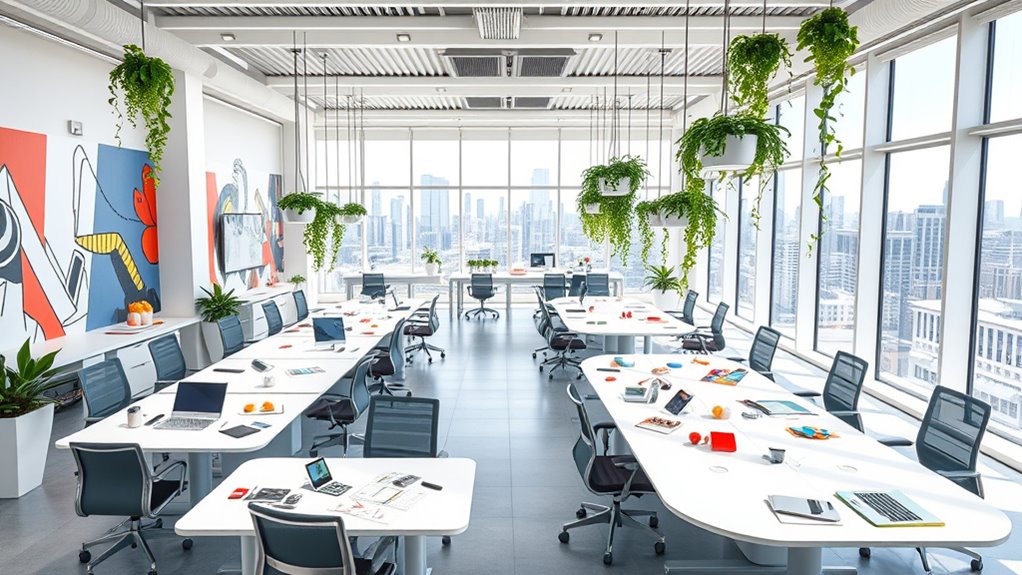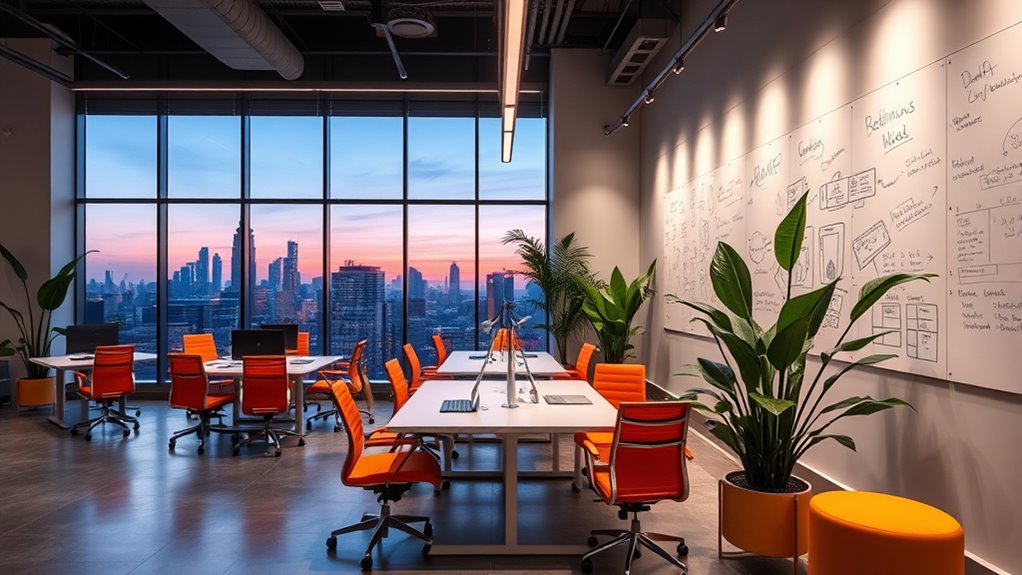To design a space that sparks creativity, focus on creating flexible, open environments that encourage interaction and idea sharing. Use movable furniture and adaptable layouts so your team can reconfigure the space to suit different needs. Foster a culture of openness where diverse perspectives are welcomed and experimentation is supported. Incorporate sustainable elements to promote environmental responsibility. When your environment invites curiosity and collaboration, you’ll see motivation and innovation thrive—continue to explore how these design principles can transform your space.
Key Takeaways
- Create flexible, open-plan spaces with movable furniture to encourage spontaneous interaction and adapt to evolving team needs.
- Design environments that promote openness, safety, and diverse perspectives to foster bold ideas and collaborative thinking.
- Incorporate sustainable and eco-friendly materials to reinforce responsible innovation and environmental consciousness.
- Use layouts that facilitate movement and connection, boosting motivation, curiosity, and risk-taking among team members.
- Cultivate a culture of experimentation and adaptability through design elements that signal openness to new ideas.

Have you ever wondered where breakthrough ideas come from? Sometimes, it’s not just about the talent or the moment of inspiration but about the environment you create around yourself. When designing a space for innovation, one of the most essential aspects is fostering collaborative environments. These spaces encourage people to interact, share ideas, and challenge each other’s thinking. Instead of isolated cubicles or rigid layouts, imagine open areas where spontaneous conversations can happen effortlessly. When team members feel connected and comfortable, creativity flows more freely, and new solutions emerge faster. Collaborative environments break down barriers, making it easier for diverse perspectives to collide and spark fresh concepts.
Fostering open, collaborative spaces sparks creativity and accelerates innovation through spontaneous interaction and diverse perspectives.
Alongside fostering collaboration, the layout of your space plays a significant role in stimulating innovation. Flexible layouts are indispensable because they adapt to different needs and working styles. Instead of fixed desks and partitions, you want open-plan areas, movable furniture, and zones that can be quickly reconfigured. This flexibility allows teams to shift between solo work, small group discussions, or larger brainstorming sessions without hassle. When people can change their environment based on the task at hand, they feel more empowered and engaged. Flexibility also encourages experimentation—if a particular setup isn’t working, you can easily tweak it. This adaptability nurtures a mindset of continuous improvement, which is essential for breakthrough thinking.
Creating a space that promotes innovation isn’t just about physical design; it’s about cultivating a culture that values openness and adaptability. You want to design environments where people feel safe to share bold ideas without fear of judgment. By integrating collaborative zones and flexible layouts, you’re not only providing the physical tools for creativity but also signaling that diverse thinking and experimentation are welcomed. As you plan your environment, consider how these elements can influence daily interactions and long-term innovation. It’s about crafting a space that invites curiosity, encourages collaboration, and allows ideas to evolve naturally.
Furthermore, designing environments with an awareness of environmental impacts and sustainable practices can reinforce responsible innovation and foster a culture of respect for the environment.
Ultimately, the environment you build should ignite motivation and facilitate connection. When people see a space that’s designed with flexibility and collaboration in mind, they’re more likely to take risks and pursue unconventional ideas. The right physical setup acts as a catalyst, transforming ordinary workspaces into fertile ground for breakthrough ideas. By intentionally creating collaborative environments with adaptable layouts, you set the stage for innovation to thrive, making it not just a goal but an everyday reality.
Frequently Asked Questions
How Can Natural Elements Be Integrated Into Innovative Workspaces?
You can integrate natural elements into your innovative workspace by adding indoor gardens, which bring greenery and improve air quality. Use natural materials like wood, stone, and bamboo for furniture and decor to create a warm, organic feel. Incorporate large windows or skylights to maximize natural light and connect your space with the outdoors. These elements foster creativity, reduce stress, and inspire collaboration, making your workspace more dynamic and inviting.
What Are Cost-Effective Ways to Redesign Existing Office Spaces for Creativity?
You can redesign your office for creativity with budget-friendly upgrades like adding colorful wall art, plants, or flexible furniture. Incorporate DIY decor ideas such as repurposing old items into functional or artistic pieces, and create cozy zones for collaboration or relaxation. These simple, cost-effective changes boost energy and inspire innovation, making your space more inviting and stimulating without breaking the bank.
How Does Lighting Influence Creative Thinking and Productivity?
Imagine sunlight flooding a room, fueling your ideas like a spark. Ambient illumination boosts your creative thinking and productivity by reducing eye strain and enhancing focus. Using color psychology, you can choose warm tones to energize or cool shades to calm, shaping mood and inspiration. Proper lighting creates an environment where your mind can wander freely, turning everyday spaces into vibrant hubs of innovation and collaboration.
What Role Do Flexible Layouts Play in Fostering Innovation?
Flexible layouts play a pivotal role in fostering innovation by allowing you to adapt your workspace quickly with adaptive furniture and create modular zones that suit different tasks. This flexibility encourages collaboration, sparks new ideas, and enhances productivity. When you can reconfigure your environment easily, you’re more likely to experiment, share ideas, and stay inspired, ultimately fueling your creative process and driving innovation forward.
How Can Technology Enhance Physical Spaces to Stimulate Creativity?
Think of technology as a magic wand transforming your space into a playground of ideas. You can enhance creativity by integrating augmented reality, which immerses you in new perspectives, and smart furniture that adapts to your needs. These tools create an environment where innovation flows freely, inspiring spontaneous collaboration and fresh thinking. By leveraging these technologies, you turn your physical space into a dynamic hub for breakthrough ideas.
Conclusion
By shaping your environment thoughtfully, you unleash creative potential and inspire breakthrough ideas. Remember, even in a world rushing toward digital dominance, a well-designed space remains your secret weapon—like a modern alchemist’s lab—turning ordinary moments into extraordinary innovations. Embrace flexibility, add personal touches, and let your surroundings spark curiosity. After all, it’s not just about the furniture; it’s about creating a sanctuary where imagination can truly soar, just like the great inventors of yore.









